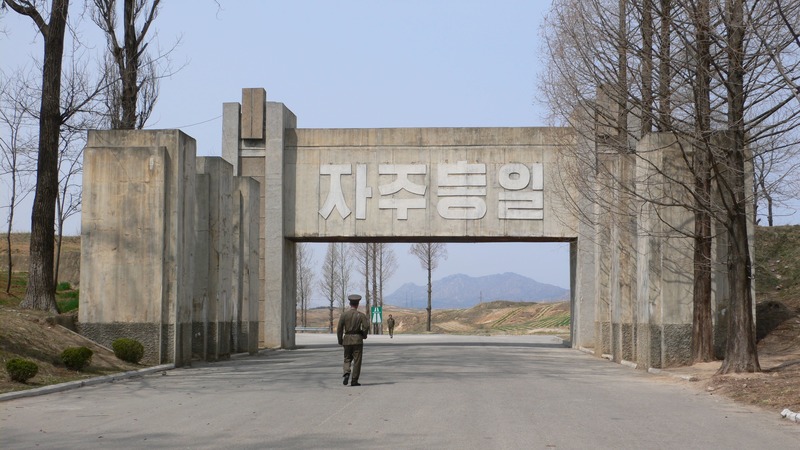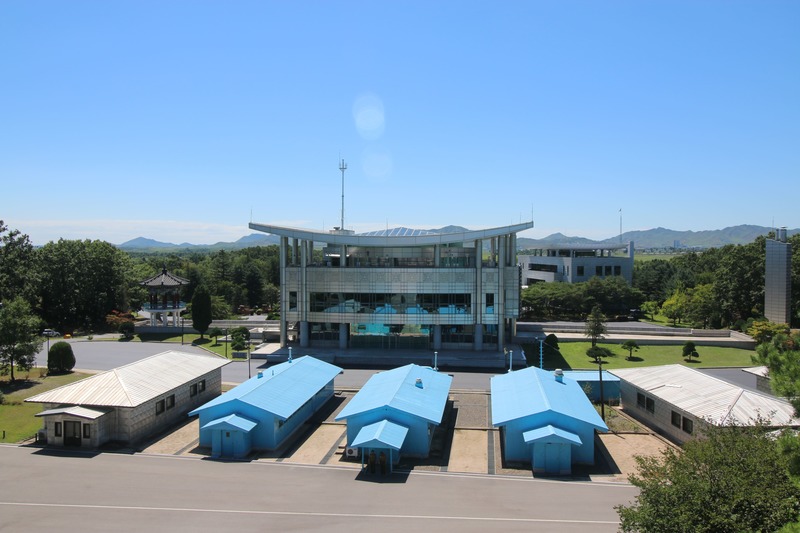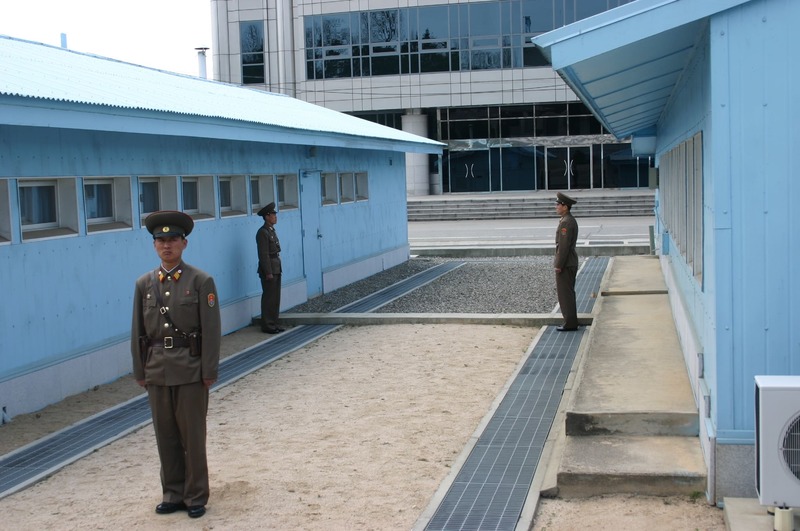What's it really like to visit the DMZ from North Korea? Is visiting Panmunjom really THAT scary?
Just Another Visit to
Panmunjom at the DMZ North Korea
What is the DMZ;
Visiting the DMZ, North Korea
Start of the DMZ Tour
Leaving the DMZ (How do you get out?)
"The scariest place on Earth" -
Former US President Bill Clinton
The DMZ (or demilitarized zone) usually with the Z pronounced ‘zee’, even by the most ardent of British pedants - is on the itinerary for almost every tourist visit to North Korea.
Or more precisely, a tiny portion of the DMZ in North Korea is.
The most visited part of the DMZ is the Joint Security Area (JSA) at Panmunjom where the two Koreas face off in a fossilized piece of Cold War history which is as tense as it is theatrical, but with a peculiar eye-of-the-storm calmness.
Of course, the DMZ is far more than Panmunjom. The DMZ slices the Korean peninsula in two.
What Is The DMZ, North Korea?
A savage 4km-wide chasm visible from space marking the spot where both armies agreed to step back under the terms of the armistice in 1953.
Cleared of all civilian settlements but two; Daesong-ri in the south and Kijong-dong in the north, and riddled with land mines, what footfall exists outside Panmunjom is mostly confined to front line guard patrols on either side of the military demarcation line (MDL).
The division itself is, of course, an entirely-avoidable tragedy that only humans could concoct. But - a sliver of silver lining exists in the subsequent rewilding of the area.
Today, there are sightings of endangered species in the Panmunjom area like Amur leopard and red-crowned crane, who care little for artificial human divisions.
Despite Panmunjom being at the heart of the DMZ, there are plenty of places that afford a better view of its full expanse.
This includes the Concrete Wall and Sea Kumgang from North Korea, and Dorasan observatory and several other spots from South Korea.
That said, for many visitors, Panmunjom is synonymous with the DMZ and is by far the most frequently visited part.
So it is the DMZ Panmunjom area upon which we will focus now.

Visiting the DMZ Panmunjom, North Korea
Entering the DMZ
Most visitors start at the camouflaged (it’s never explained quite why) blockade at the artificial end of the Reunification highway.
It’s emblazoned with Korean lettering extolling the virtues of independence, peace, and of course, reunification.
Buses are arranged in order of arrival, and grouped according to an arcane calculus understood only by the military officers who control access from this point south.
Photography is limited in the car park area. Fair enough, as it is full of soldiers.
Although, it is possible to take photographs of two posters, their slogans reminding visitors that we should pass on a reunified country to future generations, and that Korea is one.
Fine words indeed.
The earlier you arrive, the quicker you will progress (so don’t be the one who oversleeps and makes the bus late).
Some groups leave Pyongyang early in the morning and make the 3-hour drive down to the DMZ down the Reunification Highway. Other groups choose to stay in Kaesong overnight.
Kaesong is just 10 minutes away from the demilitarized zone, and therefore you can afford a short lie-in and can be sure you’ll be amongst the first groups there.
Either way, you can expect a pause upon arrival.
Arrival at the DMZ
During this time you can peruse the gift shop.
The gift shop at Panmunjom offers one of the widest selections of hand-painted propaganda posters in the country (although those that are explicitly anti-American were removed from sale in 2018), which also can descend into a rather unsavoury feeding frenzy at busy times.
You can also use this time to use the toilets opposite, or if you must (and Koryo Tours in no way endorses this as it is somewhat illegal in the DPRK) - turn on data roaming and check for a South Korean signal.
(Pro tip - If you are going to do the latter, do it here rather than gawping at your phone down at Panmunjom itself, thus missing what you came here for whilst battling military grade radio scrambling signals as you fruitlessly try to check in on Facebook. Also, have some subtlety! This kind of thing may be common enough with tourists these days but it is still not permitted. Remember that discretion is the better part of valour.)
You might notice the air-con units on the gift shop here are made by LG; after all, as the posters say - Korea is one country.
Thoughtful visitors may pause awhile and gaze back through the gates at villagers cycling to and from nearby Pyonghwa-ri (‘peace village’). This is the last settlement before the DMZ, the people of which retain an air of genteel bucolic dignity despite the daily gawking of coach loads of foreigners from the highway.
That, and the proximity of the DMZ just metres away.
Once the officer has decided which group goes with which from here on in, you will be ushered into an anteroom and given a presentation by a military officer.
Start of DMZ tour
This room is complete with maps of the Korean Peninsula and the immediate area around Panmunjom (notice though that here the South Korean flag of Daesong-ri village is replaced with a discrete plain white one).
If your group is multi-lingual then your translators will take turns, which can get a little chaotic. If you really want to hear what he is saying, try to get close to the front.
Once this is done, it is time to return to the car park and line up group by group, as if you are back at school and doing registration in the playground.
A military officer boards each bus and checks it over. Once they are satisfied, the gates rumble open and the buses progress onwards and park up.
On the commanding officer’s mark, you follow one by one on foot, walking over the threshold into the DMZ past precariously balanced barrel roadblocks above which appear to be prevented from rolling into the road only by thin ropes and small wooden doorstop chocks that look like you could remove them with a gentle tap of your fingers.
This is not the time to test that theory.
Having re-boarded your bus, you continue south down the road with your military guide.
In some ways, this portion looks like anywhere else in rural North Korea, with rolling hills, gentle oxen, and villagers working the fields by hand.
But it really isn’t.
Unfarmed areas which might be vulnerable to land attack are peppered with visible boulders and very not so visible mines.
The DMZ military guide may seem relaxed and keen on catching up on the latest gossip with your Korean guide, and you would be forgiven for forgetting that he is from a highly trained combat unit and is ultimately there for your protection.
But that he is; after all, this is a place where, to put it mildly, an awful lot of very bad things have happened.
DMZ Armistice Talks Hall and Peace Museum
Most groups make a first pit stop in the DMZ at the Armistice Talks Hall and Peace Museum.
Visually these two adjacent buildings serve as an hors d’oeuvre for the main event, but they have deep historical significance.
These buildings serve as the places where the Armistice Talks were held- dragging on with brinkmanship and farce for more than two years whilst the human misery mounted up- and then wearily signed.
Crucially, however, South Korea was not a signatory, hence the oft-cited point that these two countries remain technically at war with each other.
Incidentally, up on the hill behind these buildings, you may spy the Neutral Nations Supervisory Commission camp - the former home of Czech and Polish peacekeepers, and now an occasional restaurant where with the prior arrangement it may be possible to take lunch.
Driving to Panmunjom
Suitably historically informed, you reboard the bus and progress south.
To the right, the preposterously sized flagpoles of Kijong-dong and Daesong-ri loom into view.
After crossing the barbed wire fence and stream over the Bridge of 72 Hours, you enter the Joint Security Area.
This, now, is Panmunjom.
A nondescript disused road immediately on the right leads to the famous Bridge of No Return, the scene of tens of thousands of prisoner swaps in the Korean War.
Keep your eyes open for two incongruous modern white huts on either side of the road. These were recently erected following the Panmunjom Declaration of April 2018, and despite being on the northern side were intended for UN and ROK personnel in the spirit of detente and rapprochement.
As of the date of writing, they remain sadly empty.
Passing through overgrown forest that it would be extremely inadvisable to wander around in, the bus will pull up in a parking lot and your military officer will instruct you to disembark and walk down a short slope to view a large plaque displaying the words of - you’ve guessed it - Kim Il Sung.
The wording expresses his eternal desire for reunification and was supposedly one of his final speeches, uttered the day before his passing.
Be careful with your cameras here - photographs of the plaque are fine, but taking them in any other direction will be met with sharp shouts and whistles at best.
It may not seem so but you are just a few metres away from the DMZ military demarcation line here, so rest assured that your every move is being scrutinised.
Walking onwards, the tree line to your right abruptly gives way and suddenly - there it is. The famous blue huts, and South Korea beyond.
The nondescript guttering line in the middle of each delineates exactly where North and South Korea start and end.
And this really is a case of so near yet so far.
To travel that last stone’s throw without being mown down in a hail of gunfire requires returning to Pyongyang, flying to Beijing and on to Seoul and then travelling up from the other side.
Don’t be tempted to try the direct route.
Really.

Panmun Pavilion
After a chance for photos, you will be ushered back up the steps into the Panmun Pavilion.
This glares across at the equally imposing Freedom House on the other side.
Upstairs, you spill out onto the balcony, and this is a great vantage point from which to take in the detail, absurdity and tragedy of this place.
The famous three blue huts are part of a set of seven, the remainder of which are administered by the neutral Swedish and Swiss peacekeepers (once counterparts of the aforementioned and long-departed Czechs and Poles on the Northern side).
The area in the middle the site of the Pink Floyd-esque meeting between Kim Jong Un and Moon Jae-in in 2018, and the glitzy but ultimately less successful 2019 reprise with Donald Trump taking the place of President Moon.
Looking across to the South, you may see American or South Korean soldiers, groundskeepers casually performing mundane tasks like leaf blowing in this most insane of locations.
Or, if you are really lucky, tourists who will be under strict orders not to respond to any cheerful waves you might choose to send southwards.
Oftentimes though, all will be quiet and you will just stare over as Freedom House, fortress-like and covered in CCTV, stares back.
Who knows who is sitting in there, but rest assured they are there, watching and recording you.
From the balcony, you are facing roughly southwest here, but this is complicated by the fact that the military demarcation line bends around a corner at Panmunjom, so the North Korean settlement of Kijong-dong is clearly visible 1km behind Freedom House.
It is often claimed that this is a Potemkin village, devoid of true residents; you are close enough here to take the time to look for signs of life and decide for yourself.
Once you have sated your curiosity, and taken all the photographs you want to (yes it’s ok to take one with the military guide here, the exception here proving the rule), you can take one more look at the South and wish them well with their Starbucks, McDonald’s and internet, before returning north.
Leaving the DMZ (How to Leave?!)
There’s only one way out of the DMZ.
The road you took in.
As you sweep past villages that share the same streams, climate, families, culture and history as those just a few minutes further south.
But for an accident of history have been divided for generations - you might take the time to reflect on the birds and animals that travel freely northwards and southwards as they please... Whilst the humans live on year after year behind sadly self-imposed barriers.
